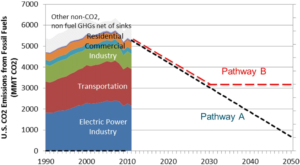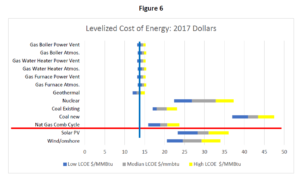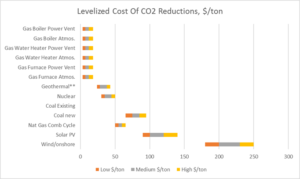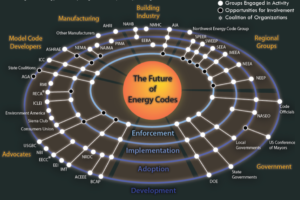Warring Against Natural Gas: Joint EEI/NRDC Statement to NARUC (crony environmentalism at work)
By Mark Krebs -- February 26, 2018“Their ‘all of the above’ debate wasn’t all of the above…. It was a propaganda stage for a ‘clean energy’ pact between EEI and NRDC for announcing their joint indoctrination campaign aimed at increasing market share of electricity at the expense of natural gas.”
“What this ‘powerful’ cabal intends to do is to monopolize energy by electricity under the guise of environmental necessity.
The National Association of Regulatory Utility Commissioners (NARUC), the national trade association representing state public service commissioners who regulate investor-owned utilities, was recently the site of a political war against natural gas. [1] On the last day of NARUC’s annual Winter Policy Summit (February 14), E&E News reported (Nation’s regulators get down to business at winter meeting): [2]
The final NARUC session on Wednesday will feature a debate of sorts between Phil Moeller, executive vice president of the Edison Electric Institute, and Ralph Cavanagh, co-director of the energy program at the Natural Resources Defense Council, on an ‘all of the above’ energy strategy.
Their “all of the above” debate wasn’t all of the above. It excluded less expensive alternatives to electricity, except as something to wean society off. Basically, it was a propaganda stage for a “clean energy” pact between EEI and NRDC for announcing their joint indoctrination campaign aimed at increasing market share of electricity at the expense of natural gas.
The following excerpts are from NRDC’s press release titled NRDC, EEI Issue Joint Statement to NARUC: [3]
“Utilities have made remarkable progress in reducing carbon and other emissions while making energy products and services even more affordable and reliable for America’s homes and businesses,” said Ralph Cavanagh, energy co-director at NRDC. “But progress must accelerate in order to combat the worst effects of climate change, lower customer bills, and clean our air. To succeed, we need a reliable, modern electric system that’s smarter, cleaner, more dynamic, more flexible, and more secure. Our joint recommendations will reduce greenhouse gas emissions and help get us there.”
“EEI’s member companies are committed to delivering America’s energy future,” added Phil Moeller, executive vice president of the business operations group and regulatory affairs at EEI. “At the center of our industry’s vision of the future is meeting customers’ needs by building and using smarter energy infrastructure, providing even cleaner energy, and creating the energy solutions customers want. This statement provides valuable opportunities to make progress on several key policy priorities, including smarter energy infrastructure, rate design, and regulatory reform.”
[The joint statement is posted at: https://www.nrdc.org/resources/nrdceei-joint-statement-state-utility-regulators]
[For elaboration on NRDC’s perspective, see this blog by Ralph Cavanagh: https://www.nrdc.org/experts/ralph-cavanagh/nrdc-eei-recommendations-will-spur-clean-energy-progress]
This pact includes the pursuit of “efficient electrification of transportation, buildings, and facilities.”
NRDC and EEI were not the only ones making this pitch at NARUC. The Electric Power Research Institute (EPRI) and the Regulatory Assistance Project were also presenting similar propaganda; some of which also on the web:
- A magazine on electrification that you can sign up for at NEMA’s website
- A “preview” of EPRI’s study on U.S. National Electrification Assessment
- A flyer for EPRI’s upcoming Electrification 2018 conference & exposition
- The Regulatory Assistance Project (RAP) “Beneficial Electrification” series http://www.raponline.org/?sfid=5489&_sf_s=beneficial%20electrification
Background: ‘Decarbonization”
For years now, Master Resource fans (and others who “lurk” there) have been reading about “clean energy” and how it is a front for “deep decarbonization” and “beneficial electrification.” Most of these articles are archived at Master Resource here:
- https://www.masterresource.org/category/krebs-mark/
- https://www.masterresource.org/category/krebs-mark/page/2/
For further reading about these ploys, please refer to the IER article of July 14, 2017, titled ‘‘Deep Decarbonization’ vs. Direct-Use Natural Gas.” Also see the January 3, 2018, Master Resource article by Steve Goreham titled ‘Electrification’: The Road to Higher Energy Prices. [4]
Evaluation
Therefore, while these subjects should be nothing new for Master Resource readers, what is new is the extent that such self-serving propaganda is now being openly presented as critically needed policy to avoid an environmental catastrophe. This article isn’t about picking a suicidal fight with the electric industry or their environmentalists “bestest buddies.”
Rather, it’s a wake-up call to American consumers and those that think free markets best serve the enlightened interests of consumers. What this “powerful” cabal intends to do is to monopolize energy by electricity under the guise of environmental necessity.
This will vastly increase consumer cost and further entrench the already entrenched. Increased consumer costs would (mainly) come in the form of:
- Increased electric rates for building generation, transmission and distribution systems needed to displace natural gas direct use
- Expenses for consumers to replace their gas appliances with electric ones and upgrade their electric service panels and internal wiring for these new electric appliances.
In case you just can’t quite believe it yet, maybe you will believe EEI and their consultants. Growth potential from total electrification was the subject of a recent article titled EEI 2017: The utility sector’s business case for deep decarbonization. [5] This article was about EEI’s 2017 “annual summit.” The following excerpt captures the essence of this article:
All this carbon cutting could result in a windfall for the power sector,” said Sue Tierney, a principal at the Analysis Group. In her analysis of more than four dozen studies on deep decarbonization, she found that some anticipate that “electricity demand will have essentially doubled compared to where it is today as a result of those changes.”
The flaw in Ms. Tierney’s logic is that she appears to have seriously underestimated how much electricity demand would need to increase. This is particularly true in climates subject to “polar vortex’ and “bomb cyclone” cold weather emergencies.
The following graphic summarizes the “deep decarbonization” through “mass electrification ploy:
Illustrative Deep Decarbonization Trajectory and “Dead End” Trajectory [6]
What “Pathway A” is supposed to illustrate is the linear path to near-zero CO2 emissions that is ostensibly achievable both technically and economically. What “Pathway B” is supposed to illustrate is that “you can’t get there from here” if you allow fossil fuel use.
However, the stacked area chart portion of the graph also illustrates something they don’t want to discuss: The direct consumption of natural gas by the American public is a minor cause of CO2 emissions. Also note that there are no cows to be found in this chart. We should be able to add cows, rice, and other manmade GHG emissions to put buildings further into perspective as the last thing needing attention, instead of the first.
Their strategy involves replacing gas with electric options at end of useful life every time (e.g., a nice shiny new electric range, heat pump, resistance water heater, and dryer for everyone). They will probably try to make this mandatory. After all, they say this is necessary “to save the children.” Well, maybe not these children: “Child miners aged four living a hell on Earth so YOU can drive an electric car.” [7]
The direct consumption of natural gas also provides lower cost to consumers as the following chart illustrates, for those applications where it can be used. The chart is from Levelized Cost of Energy: Expanding the Menu to Include Direct Use of Natural Gas, by Thomas Tanton, published in August 2017. [8]
Assuming decarbonization is a worthy pursuit and so is the economic efficiency in doing so, then the following chart (also from Tom Tanton) illustrates the economics of the carbon reductions associated with natural gas appliance use relative to electric powerplant alternatives:[9]
Another recent excerpt that reveals this regulatory “command and control” strategy comes from EPRI’s preview study listed above (at page 6):
Updating energy efficiency codes. A review of efficiency measurement and cost tests (e.g., for appliances, heating, and transport) is needed to remove fuel bias and frame regulations that enable efficient electrification and continue to encourage traditional energy efficiency.
Many of the previous Master Resource article (available in the Krebs archives) discuss these energy efficiency codes & standards issues. In short, codes and standards are often written to favor electrical appliances at the expense of more fuel cycle efficient natural gas. But here is the gist of it in one graph (taken from the NRDC funded “Building Codes Assistance Project” website [10]) that I like to call “the Borg Collective”:
Conclusion
In closing; a little reminder for those that forget history:
“If you tell a lie big enough and keep repeating it, people will eventually come to believe it. The lie can be maintained only for such time as the State can shield the people from the political, economic and/or military consequences of the lie. It thus becomes vitally important for the State to use all of its powers to repress dissent. …”
– Joseph Goebbels.
———————-
Mark Krebs, an engineer by training, has been involved with energy efficiency design and program evaluation for more than thirty years. He has served as an expert witness in dozens of energy-efficiency filings, which he summarized in a Public Utilities Fortnightly article, “It’s a War Out There: A Gas Man Questions Electric Efficiency” (December 1996). For more about Mark, please see Mark Krebs: Digging Down on Energy Efficiency Claims (an interview).
——————
[2] https://www.eenews.net/energywire/2018/02/09/stories/1060073369
[3] https://www.nrdc.org/media/2018/180214-0
[4] https://www.masterresource.org/deep-decarbonization/electrification-higher-prices/
[5] https://www.utilitydive.com/news/eei-2017-the-utility-sectors-business-case-for-deep-decarbonization/444873/
[6] Figure 25 (page 53) of “Policy Implications of Deep Decarbonization in the United States” published by Energy and Environmental Economics, Inc. (E3) and the Deep Decarbonization Pathways Project (DDPP) and funded by Tom Steyer. (http://deepdecarbonization.org/wp-content/uploads/2015/11/US_Deep_Decarbonization_Policy_Report.pdf)
[7] http://www.dailymail.co.uk/news/article-4764208/Child-miners-aged-four-living-hell-Earth.html
[8] https://www.apga.org/resources/lcoe
[9] Levelized Cost of Energy: Expanding the Menu to Include Direct Use of Natural Gas




They are not likely to get as much help from DOE as they have in the past, at least for the next 3-7 years.
Nice job, Mark.
That’s what Ive been hoping Ed. OTOH: EERE’s official mission statement is still focused on “the transition to a global clean energy economy.”
https://energy.gov/eere/about-office-energy-efficiency-and-renewable-energy
And EERE is still sponsoring this kind of stuff:
“NREL (et. al.) Electrification Futures Study: End-Use Electric Technology Cost and Performance Projections through 2050”
https://www.nrel.gov/analysis/electrification-futures.html
Then scroll down to box labeled “Just Released—December 2017:”
“Primary funding support for the EFS is provided by the DOE Office of Energy Efficiency and Renewable Energy Office of Strategic Programs.”
Maybe this could be just a contractual artifact form the Obama budget but maybe not.
[…] Update: These electrification goals from 1996[4] have not been realized. But they haven’t given up. In fact, they have expanded to attain a monopoly on energy. For more details, see the recent MasterResource article titled Warring Against Natural Gas: Joint EEI/NRDC Statement to NARUC (crony environmentalism at work). […]
[…] direct use of natural gas is picking up steam in other states and at the Federal level (see here, here, and […]